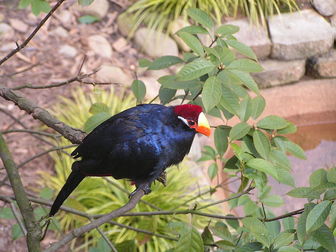Violet Turaco
These are unmistakable birds, although often inconspicuous in the treetops. They are 45 cm long, including a long tail. Their plumage is glossy violet except for the thick red bill, yellow forehead and chestnut crown. In flight, Violet Turaco's crimson primary flight feathers contrast with the violet plumage.

Original source: PICT0172Uploaded by Snowmanradio
Author: Rob Wynne from Alpharetta, GA, USA
The Violet Turaco is classified as Least Concern. Does not qualify for a more at risk category. Widespread and abundant taxa are included in this category.
The Violet Turaco (Musophaga violacea) is a large turaco, a group of African near-passerines. It is a resident breeder in the forests of tropical west Africa. It lays two eggs in a tree platform nest. These are unmistakable birds, although often inconspicuous in the treetops. They are 45 cm long, including a long tail. Their plumage is glossy violet except for the thick red bill, yellow forehead and chestnut crown. In flight, Violet Turaco's crimson primary flight feathers contrast with the violet plumage. More
The Violet Turaco resides in the forests of tropical west Africa. Senegambia, Southwest Mali, Burkina Faso, South Niger, Guinea-Bissau, Guinea, Liberia, Ivory Coast, Ghana, Togo, Benin, Nigeria, and Cameroon. They are absent from Sierra Leone, but isolated populations can be found along the Chad / Central African Republic border. These are distinctive birds, although often inconspicuous in the treetops.They can be see in open woodland, in riverine forest and humid forest edge. More
Violet Turacos are found in West Africa from Gambia and Senegal east to Cameroon. They inhabit the open woodland, riverine forest, and humid forest edge. They live in lower lying territories and only seldom venture above altitudes of 1000 meters. More
The Violet Turaco's plumage is primarily a glossy violet except for its thick red bill, yellow forehead and chestnut crown. In flight, Violet Turaco's crimson primary flight feathers contrast with the violet plumage. They range up to two feet in length with a long tail and short wings. Their coloring makes them striking but inconspicuous in their natural habitat. HABITAT They are arboreal, and are found in the forest treetops throughout tropical West Africa (except Sierra Leone). More
In flight, Violet Turaco's crimson primary flight feathers contrast with the violet plumage. The Violet Turaco (Musophaga violacea) is a large turaco, a group of African near-passerines. It is a resident breeder in the forests of tropical west Africa. It lays two eggs in a tree platform nest. More
Violet turacos at Edinburgh Zoo Edinburgh Zoo has two violet turacos, a male and a female. The male was hatched in 1996 and came to us in 2006 from the Paradise Wildlife Park in Cornwall. The female was hatched in 2008 and also came to Edinburgh Zoo in 2009. Turacos are often quite vocal, making a rasping “wheezy”-sounding call. Look for the flash of red on their wings as they fly around in their enclosure. More
The violet turaco is native to western Africa from Gambia and Senegal east to Cameroon and prefers open woodland, riverine forest, humid forest edges and rarely ventures above altitudes of 1000 meters. Their diet consists of fruit (especially figs), snails and insects. They are shy perching birds preferring to stay out of sight in the dense canopy of tall trees. More
Violet Turaco, Gambia, Abuko 3 January 2006 © Jim Willson Video Capture Violet Turaco - Violet Turaco, Cameroon, Benoue may 2007 © Paul Noakes Send this as a postcard Violet Turaco - Violet Turaco, Ghana, Mole NP March 2008 © Sam Woods/Tropical Birding NEW 2008 Ghana Trip Report Send this as a postcard Violet Turaco - Violet Turaco, More
White-crested Turaco and outrageous Violet Turacos feasting on ripe figs, surrounded by Western Plantain Eaters, Violet-backed and Purple Glossy Starling and several African Thrushes. Having two of Africa’s most spectacular turacos in a single tree is a serious treat. Both Viellot’s and Bearded Barbet joined them eventually. The remainder of the morning was spent birding some more riverine forest and scrub. More

Original source: Kilom691
Author: Kilom691
Permission: Some rights reserved
Family : Musophagidae
Genus : Musophaga
Species : violacea
Authority : Isert, 1789
